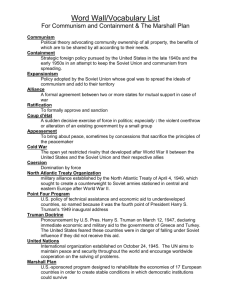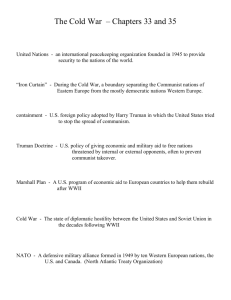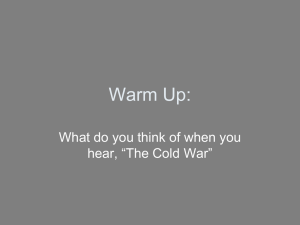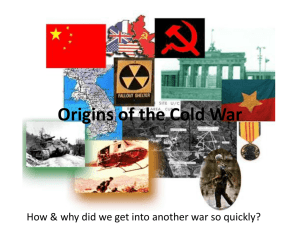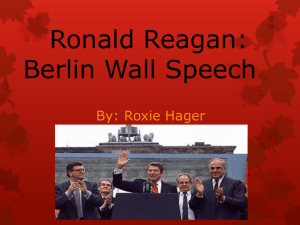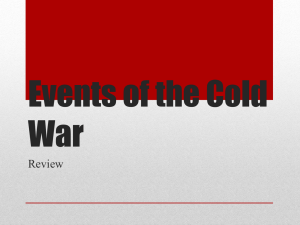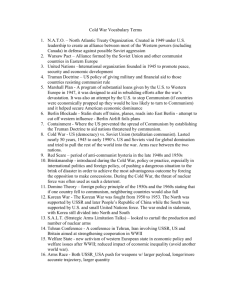Name ____ Date ______ Pd ______ The Cold War – Part 1: Video
advertisement
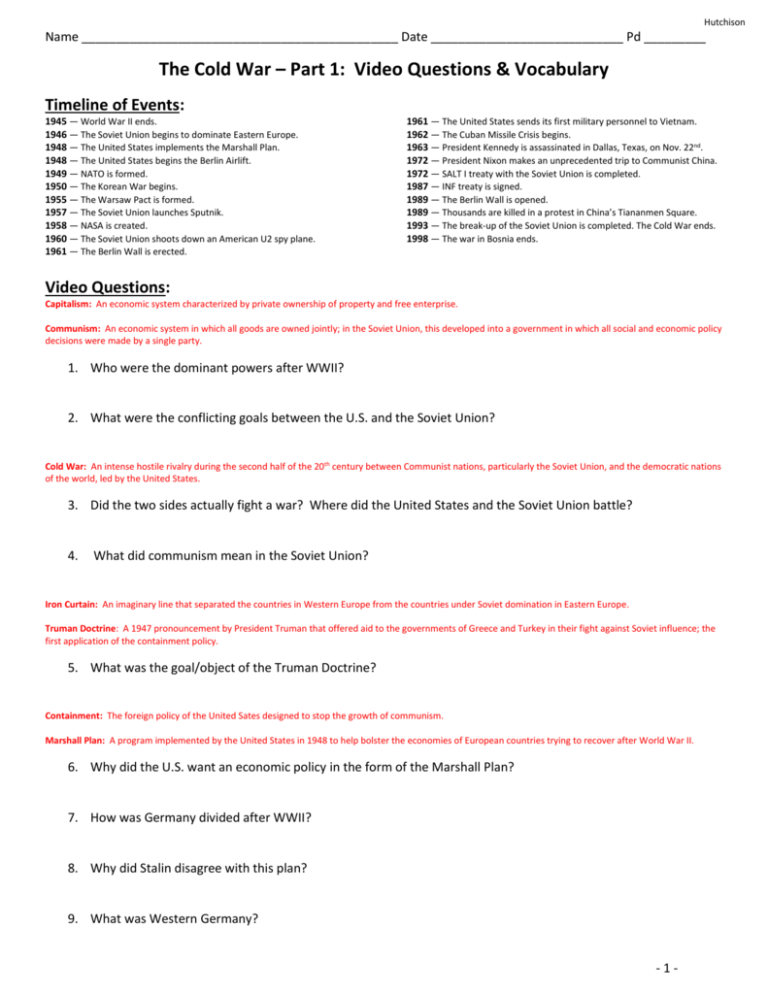
Hutchison Name ______________________________________________ Date ____________________________ Pd _________ The Cold War – Part 1: Video Questions & Vocabulary Timeline of Events: 1945 — World War II ends. 1946 — The Soviet Union begins to dominate Eastern Europe. 1948 — The United States implements the Marshall Plan. 1948 — The United States begins the Berlin Airlift. 1949 — NATO is formed. 1950 — The Korean War begins. 1955 — The Warsaw Pact is formed. 1957 — The Soviet Union launches Sputnik. 1958 — NASA is created. 1960 — The Soviet Union shoots down an American U2 spy plane. 1961 — The Berlin Wall is erected. 1961 — The United States sends its first military personnel to Vietnam. 1962 — The Cuban Missile Crisis begins. 1963 — President Kennedy is assassinated in Dallas, Texas, on Nov. 22nd. 1972 — President Nixon makes an unprecedented trip to Communist China. 1972 — SALT I treaty with the Soviet Union is completed. 1987 — INF treaty is signed. 1989 — The Berlin Wall is opened. 1989 — Thousands are killed in a protest in China’s Tiananmen Square. 1993 — The break-up of the Soviet Union is completed. The Cold War ends. 1998 — The war in Bosnia ends. Video Questions: Capitalism: An economic system characterized by private ownership of property and free enterprise. Communism: An economic system in which all goods are owned jointly; in the Soviet Union, this developed into a government in which all social and economic policy decisions were made by a single party. 1. Who were the dominant powers after WWII? 2. What were the conflicting goals between the U.S. and the Soviet Union? Cold War: An intense hostile rivalry during the second half of the 20th century between Communist nations, particularly the Soviet Union, and the democratic nations of the world, led by the United States. 3. Did the two sides actually fight a war? Where did the United States and the Soviet Union battle? 4. What did communism mean in the Soviet Union? Iron Curtain: An imaginary line that separated the countries in Western Europe from the countries under Soviet domination in Eastern Europe. Truman Doctrine: A 1947 pronouncement by President Truman that offered aid to the governments of Greece and Turkey in their fight against Soviet influence; the first application of the containment policy. 5. What was the goal/object of the Truman Doctrine? Containment: The foreign policy of the United Sates designed to stop the growth of communism. Marshall Plan: A program implemented by the United States in 1948 to help bolster the economies of European countries trying to recover after World War II. 6. Why did the U.S. want an economic policy in the form of the Marshall Plan? 7. How was Germany divided after WWII? 8. Why did Stalin disagree with this plan? 9. What was Western Germany? -1- Name ______________________________________________ Date ____________________________ Pd _________ Blockade: A military strategy that attempts to isolate a country by preventing the movement of its people and goods. 10. Because the creation of Western Germany angered Stalin, what did he do in response? 11. What was the Berlin Airlift? North Atlantic Treaty Organization (NATO): A mutual defense alliance established in 1949 between the United States, Canada and several Western European countries designed to safeguard Western Europe against Soviet attack. Warsaw Pact: A mutual defense organization established in 1955 by the Soviet Union and several Eastern European countries. 12. How did the U.S. find out that the Russians had nuclear weapons? 13. What happened as a result? 14. What other country rose to power as a communist nation? 15. What happened to Korea after WWII? Which philosophy was followed by each part? 16. What was the outcome of the Korean War? 17. What was Sputnik? Why were the Americans concerned with this accomplishment? 18. Why did the U.S. government create NASA? 19. How did American society reflect concerns with the threat of a nuclear attack? 20. How did the Soviets shooting down a U.S. plane affect plans for reducing tensions between the U.S. and President Dwight D. Eisenhower and the Soviet leader Khrushchev? 21. How was life different for people in West Germany versus East Germany? 22. Why was the Berlin Wall created in 1961? 23. What was concrete evidence of the Cold War? 24. What was the first successful revolution in the Americas? 25. How did the U.S. respond? -2- Name ______________________________________________ Date ____________________________ Pd _________ 26. What was the purpose of the Bay of Pigs Invasion? 27. Why did the invasion fail? 28. What led to the Cuban-Missile Crisis? Who was President of the U.S. during this time? 29. What was the result of the Cuban-Missile Crisis? 30. What was the first significant agreement between the U.S. and Soviet since WWII? What event quickly triggered the end of this reduction in tension? 31. What happened to the leader of the Soviet Union? Domino Theory: The fear that the spread of communism would run rampant among neighboring countries if one were to fall under Communist influence. 32. What is the example that proved the domino theory to be legitimate? 33. What is détente? Who was the U.S. president for this time? Strategic Arms Limitation Treaty (SALT I): Agreement between the United States and Soviet Union intended to limit the proliferation of long-range nuclear weapons. 34. Why did Reagan target Latin America in the fight against communism? Contra: A member of a military group that fought the Sandinista government in Nicaragua. 35. Why did Reagan support the Contras? What did this lead to? 36. How much had the U.S. spent on the fight against communism? Strategic Defense Initiative (SDI): A program proposed by President Reagan in 1983 that was intended to provide the United States with a space-based defense system to guard against possible nuclear attacks. 37. How did the SDI or “Star Wars” program help bring down communism in the Soviet Union? Who was the leader of Russia at this time? Intermediate Nuclear Force Treaty (INF): An agreement signed by President Reagan and Soviet President Gorbachev in 1987 that called for the elimination of medium-range nuclear weapons. Glasnost: A policy of political openness in Soviet society instituted by leader Mikhail Gorbachev. Perestroika: The restructuring of the failing Soviet economy, allowing for limited free enterprise under Mikhail Gorbachev. -3- Name ______________________________________________ Date ____________________________ Pd _________ 38. How did Glasnost and Perestroika lead to the downfall of communism in Europe? 39. What event triggered the reuniting of Germany? 40. Who became the next leader of Russia? 41. What was the Tiananmen Square Massacre about? 42. How did the end of communism affect Yugoslavia? Who was the U.S. President during this time? 43. Why was it difficult for countries to adjust to international conflicts after the end of the Cold War? Cold War Vocabulary German Zones Iron Curtain Containment Truman Doctrine Marshall Plan Creation of West Germany Berlin Air Lift 38th Parallel Soviet Bloc Arms Race Sen. Joseph McCarthy Mao Zedong Chiang Kai-shek Gen. Douglas MacArthur Nikita Khrushchev -4- Name ______________________________________________ Date ____________________________ Pd _________ Sputnik NASA fallout shelters Non-Aligned Nations Fidel Castro U2 Spy Plane Incident Berlin Wall Bay of Pigs Cuban Missile Crisis Oct 15-28, 1962 (13 Days) Blockade “Secret” Agreement Kennedy’s Berlin Speech Vietnam War Domino Theory Détente Ping Pong Diplomacy SALT Strategic Arms Limitation Treaty Ronald Reagan Margaret Thatcher Iran-Contra Scandal SDI (Star Wars) Strategic Defense Initiative Mikhail Gorbachev Glasnost -5- Name ______________________________________________ Date ____________________________ Pd _________ Perestroika Pope John Paul II Lech Walesa Reagan’s Berlin Speech Tiananmen Square June 4, 1989 Berlin Wall torn down Nov 1989 Boris Yeltsin Break-up of the USSR -6-
